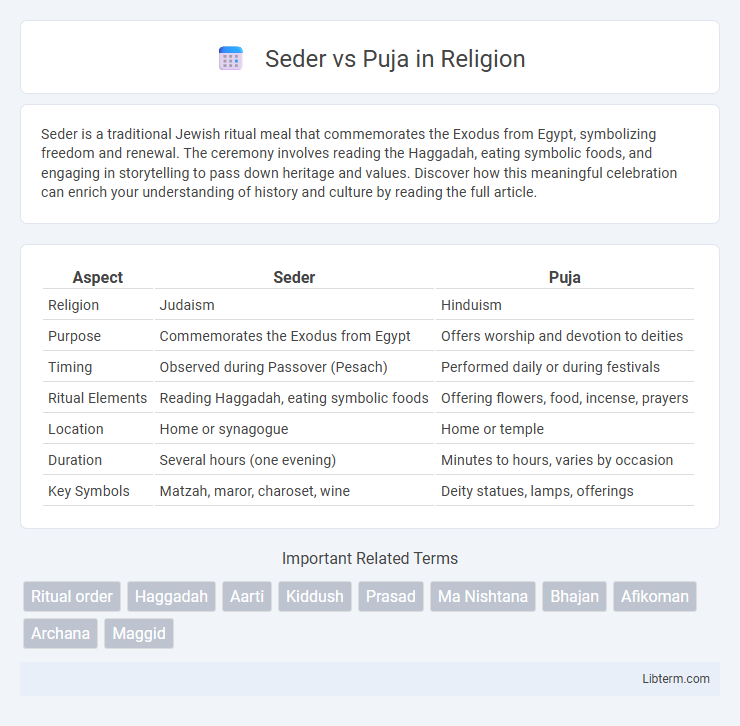Seder is a traditional Jewish ritual meal that commemorates the Exodus from Egypt, symbolizing freedom and renewal. The ceremony involves reading the Haggadah, eating symbolic foods, and engaging in storytelling to pass down heritage and values. Discover how this meaningful celebration can enrich your understanding of history and culture by reading the full article.
Table of Comparison
| Aspect | Seder | Puja |
|---|---|---|
| Religion | Judaism | Hinduism |
| Purpose | Commemorates the Exodus from Egypt | Offers worship and devotion to deities |
| Timing | Observed during Passover (Pesach) | Performed daily or during festivals |
| Ritual Elements | Reading Haggadah, eating symbolic foods | Offering flowers, food, incense, prayers |
| Location | Home or synagogue | Home or temple |
| Duration | Several hours (one evening) | Minutes to hours, varies by occasion |
| Key Symbols | Matzah, maror, charoset, wine | Deity statues, lamps, offerings |
Introduction: Seder and Puja Explained
Seder is a traditional Jewish ritual meal commemorating the Exodus from Egypt, observed during Passover with symbolic foods and recitations from the Haggadah. Puja is a Hindu worship ritual involving offerings, prayers, and chants to deities, performed in temples or homes to invoke divine blessings. Both practices embody deep spiritual symbolism and cultural heritage, serving as essential expressions of faith in Judaism and Hinduism respectively.
Origins: Historical Background of Seder and Puja
The Seder originates from ancient Jewish traditions commemorating the Exodus from Egypt, deeply rooted in biblical narratives and Rabbinic teachings dating back over 3,000 years. Puja traces back to early Vedic rituals in the Indian subcontinent, evolving through centuries within Hinduism, Buddhism, and Jainism as a ceremonial worship practice involving offerings to deities. Both rituals reflect distinct historical and cultural developments, embodying spiritual symbolism and community identity in Judaism and Dharmic religions, respectively.
Purpose and Spiritual Significance
The Seder, a central ritual in Jewish Passover, commemorates the Exodus from Egypt and symbolizes liberation and divine redemption, fostering communal memory and spiritual renewal. Puja, a Hindu worship ceremony, serves as a devotional offering to deities, expressing reverence, gratitude, and seeking blessings to strengthen the devotee's spiritual connection. Both practices emphasize profound spiritual significance through ritual acts that reinforce faith, identity, and the relationship between humans and the divine.
Core Rituals and Practices: Seder vs Puja
The Seder is a Jewish ritual meal held during Passover, featuring the reading of the Haggadah, eating symbolic foods like matzah and bitter herbs, and recounting the Exodus from Egypt. Puja is a Hindu worship ceremony involving offerings of flowers, food, and incense to deities, accompanied by prayers and chants to invoke divine blessings. Both rituals emphasize symbolic acts and storytelling but differ in their religious context, structure, and the specific objects or offerings used.
Sacred Texts and Symbolism
The Seder, rooted in the Haggadah, retells the Exodus story using symbolic foods like matzah and maror to represent slavery and bitterness, emphasizing Jewish liberation. Puja rituals invoke deities based on sacred Hindu texts such as the Vedas and Puranas, with offerings like flowers, incense, and lamps symbolizing devotion and spiritual purification. Both practices utilize deeply meaningful symbols and texts to convey foundational religious narratives and foster spiritual connection.
Ceremonial Foods and Offerings
Seder features symbolic foods such as matzah, maror, charoset, and a roasted shank bone, each representing elements of the Exodus story and Jewish freedom. Puja involves offerings like fruits, sweets, rice, flowers, and sometimes cooked dishes, presented on a plate or banana leaf to honor deities and invite blessings. Both ceremonies use food as a medium of spiritual significance, connecting participants to tradition and divine presence through ritual consumption or presentation.
Role of Community and Family
Seder and Puja both emphasize the vital role of community and family in religious practices, serving as occasions for collective participation and spiritual bonding. During a Seder, Jewish families and friends gather to retell the Exodus story, reinforcing cultural identity and shared heritage through communal rituals and symbolic foods. Similarly, Puja involves family and community members coming together to perform worship, fostering unity and devotion while preserving cultural traditions across generations.
Festivals: Passover Seder and Hindu Puja Celebrations
Passover Seder is a Jewish ritual feast marking the beginning of Passover, featuring symbolic foods such as matzah and maror that commemorate the Exodus from Egypt. Hindu Puja celebrations are devotional worship ceremonies performed during various festivals like Diwali and Navaratri, involving offerings to deities, chanting, and rituals to invoke divine blessings. Both traditions emphasize communal gathering, sacred symbolism, and the reaffirmation of faith through ritual practices.
Modern Adaptations and Global Influence
Modern adaptations of the Seder incorporate digital Haggadot and virtual gatherings, enabling global Jewish communities to connect and celebrate Passover despite geographical barriers. Puja rituals have similarly embraced technology, with live-streamed ceremonies and online offerings allowing Hindu practitioners worldwide to participate in religious observances. Both traditions demonstrate significant global influence by blending ancient customs with contemporary practices, fostering broader accessibility and inter-cultural exchange.
Seder vs Puja: Key Differences and Similarities
Seder and Puja both serve as central religious rituals in Judaism and Hinduism, respectively, involving specific prayers, symbolic foods, and spiritual meanings. While Seder is a Passover meal commemorating the Exodus from Egypt with a set order of rituals and storytelling, Puja is a worship ceremony honoring deities with offerings, chants, and prayers tailored to various festivals or daily devotion. Both practices emphasize family participation, spiritual reflection, and the use of symbolic elements to convey religious teachings and cultural heritage.
Seder Infographic

 libterm.com
libterm.com